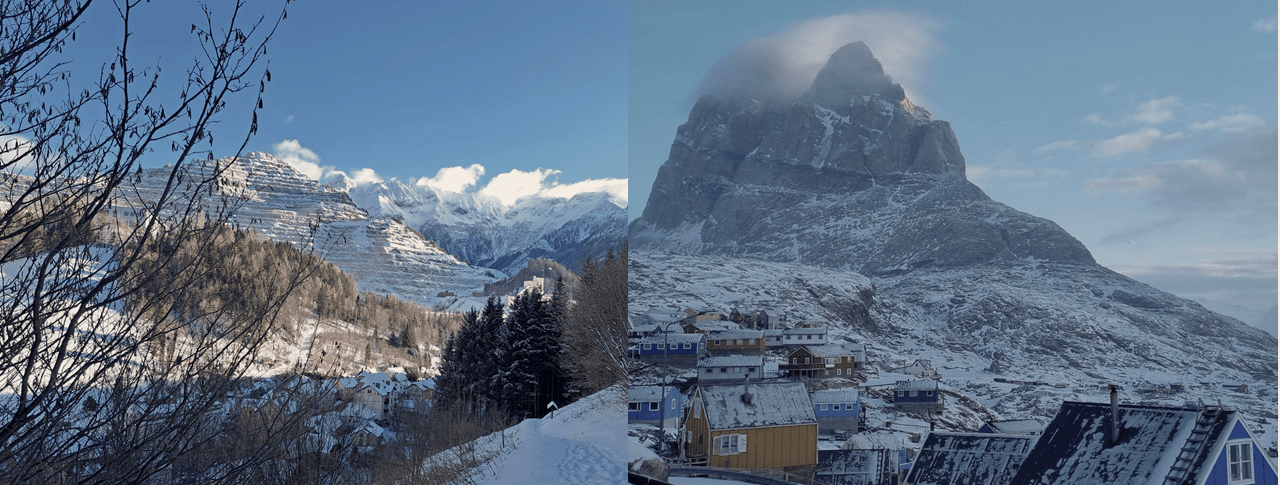Snow is a crucial component of our climate system, which is rapidly changing due to climate change. It also plays an essential role in people’s lives, especially those residing in the Arctic (e.g., Greenland) or mountainous regions (e.g., the Austrian Alps). In the Snow2School project, scientists and students work together to track changes in snow and assess what these changes mean for both communities and the climate.
Snow Photos and their Stories: How Arctic and Alpine Youth are Participating in Snow Research
The interdisciplinary citizen science project Snow2School, funded by Sparkling Science (OeAD Center for Citizen Science) brings together climatologists from the University of Graz, social anthropologists from the University of Vienna, and teachers and students from two local schools in Uummannaq, northwest Greenland, and Eisenerz in the Austrian Alps. The students, aged between 12 and 17, act as junior researchers in the project. Considering the effects of climate change in the Arctic and the Alps, the project’s main objective is to explore past and present snow changes and their meaning for local communities in both regions. This is being done employing both qualitative and quantitative methods, including interviews, snow measurements and mono- and interdisciplinary workshops, complemented by an element of intercultural online exchange. The core of the research involves both historical and contemporary snow photographs, which not only visually document changes in snow patterns and enable their quantitative analysis but also offer insights into changing human-environment relations in both research areas. The junior researchers collect photos, stories from their families and communities as well as environmental data with guidance from the scientific project team to explore snow changes in the past and present.
Left: Great-grandparents in front of an alpine hut in Etmissl, 1980 (© Vanessa Löcker, BORG Eisenerz 6th grade). Right: Radmer, 1963 (© Lara Dobnigg, BORG Eisenerz 7th grade).

28th of December 2023, Lainbach, municipality of Landl (© Jonas Stübler, BORG Eisenerz 6th grade).
Snow2School and Social Anthropology
The anthropological component of the research project focuses on understanding the changing snow and environmental conditions, and how they impact communities in key regions affected by climate change, namely the Arctic and the Alps. In collaboration with the local communities and the vital assistance of the students, snow photographs and their stories are being collected through different interview techniques including photo elicitation. Anthropologists are especially interested in the narratives and emotions that these images convey as well as the personal stories tied to a transforming environment. Moreover, social science workshops are being carried out aimed at both teaching research skills to the students and together developing themes and objectives for the interviews. Additionally, the anthropological team members seek to create a meaningful exchange between the two partner schools through online communication, fostering cross-cultural learning and a deeper understanding of environmental change in different regions of the world (Elixhauser & Gusenleitner, 2025).
Climate science and artificial intelligence (AI)
In the case of the Austrian Alps, snow measurements date back ca 130 years, providing us with a wealth of knowledge about changing snow conditions in this region. Unfortunately, we know much less about Greenland in this regard, where only very few and shorter time series with snow-related information are available. Keeping in mind that Greenland is approximately 25 times bigger than Austria, the difference in data density is large.

Snow observations in the Alps (adjusted, © Matiu et al., 2021).
Snow observations in Greenland (adjusted, © Van der Schot et al., 2024).
One of the goals of the climate science perspective of the Snow2School project is to improve the knowledge about snow conditions in Greenland. By using (historical) photographs collected by the students, and other sources, we will attempt to reconstruct past snow depths by applying AI methods. With the information available in the Eisenerz region we can test our new reconstructive method using data from snow observations. Ideally, this method can then be applied to Greenland to learn more about past snow conditions there as well.
Transdisciplinary snow research
Essentially, Snow2School follows an interdisciplinary citizen science approach. Due to the integration of different disciplinary and non-academic types of knowledge—particularly suited to address societal challenges like climate change—the project also falls into the category of transdisciplinary research. With the snow photos at the heart of this collaborative research, a photo exhibition in Eisenerz is one example of this transdisciplinary effort. Featuring the collective work of the scientific project team, the Austrian partner school BORG Eisenerz, and the Eisenerz town museum and avalanche commission, the Snow2School photo exhibition started with a large kick-off event at BORG Eisenerz. It was then moved to the historic center of Eisenerz, where it will remain on display until March 2025. Other than the social science workshops and one interdisciplinary workshop carried out with the students from BORG Eisenerz so far, a workshop focused on climate science is in preparation to be carried out this or next winter season.
The field trips in Uummannaq are also characterized by close collaboration between the climate scientists and anthropologists, the students as well as staff members from the partner school Atuarfik Edvard Kruse and other community partners such as the Uummannaq children’s home. Various combined indoor and outdoor workshops took place in 2023 and 2024, both in Uummannaq town and in the smaller settlement of Ukkussissat, that aimed at teaching the students both qualitative and quantitative methods of doing snow research. For instance, the students learned to conduct short interviews with community members to study (and to explain to us) the experiences of the Ummannarmiut (people of Uummannaq) regarding changes in snow and environmental conditions over time, as well as their ways of knowing. A photo competition is planned for spring 2025, which will be followed by an exhibition in the school.
Physical snow properties were assessed in both locations during these workshops. Students of different ages were involved – while in Uummannaq, we worked with junior researchers aged around 15 years, in Ukkussissat, the kids were between 6 and 10 years old. We discussed snow stratification and post-depositional processes as well as local variability by applying different sampling sites in the close vicinity. Also, we turned it into a competition to find the largest snow crystal in the area and determined snow temperature gradients in the snowpack. We found it refreshing to obtain data on the physical properties of snow in a setting that attempts to combine a hands-on experience of snow with an understanding of its characteristics.

Junior researchers in Ukkussissat, April 2024 (© Andreas Trügler).
Several devices for long-term monitoring were installed together with the junior researchers. In doing so, we have focused on an approach that creates ‘ownership’ of the instruments, which includes taking into account practical issues beforehand, asking: how can we prevent the instruments from being covered by snow, what are the expected ranges and are we covering the physical property in a resolution relevant for our research questions?
Time-lapse photos of the iconic Uummannaq Mountain April-July 2024, camera mounted in cooperation with the junior researchers in Uummannaq (© Snow2School).
Snow, ice, changing traditions and emerging opportunities – early insights from Snow2School
Besides the shared objective of developing a citizen science approach for snow research, the anthropological research aims to explore the long-term experiences of the residents of the Eisenerz and Uummannaq region. Initial findings from Eisenerz show that snow events, particularly extreme snow events, have always played a central role in people’s everyday lives. Similar to other Alpine regions, weather extremes are increasing, and seasons have become more unpredictable. Although winters are still occasionally snowy, fewer days with continuous snow are being observed. The anthropological research suggests that the topic of anthropogenic global climate change is especially relevant to the school students’ generation. Local environmental changes though, particularly changes in snow conditions, are generally seen as less concerning so far. Some inhabitants of Eisenerz even highlight the positive aspects of their town’s Alpine location, noting that while summers are getting hotter, the temperatures here stay relatively cool compared to urban areas in Austria. In light of the significant outmigration in Eisenerz following the decline of the extractive industries since the 1990s, they see this as a potential boost for regional development. Understanding the various perspectives and meanings that these environmental changes evoke among the residents of Eisenerz and its wider Alpine region remains an important focus of the ongoing field research.
Preliminary anthropological findings from Uummannaq suggest that changes in snow cover are less directly relevant to the daily lives of Uummannarmiut than changes in ice conditions. Similar to Eisenerz, the snow cover in Uummannaq is decreasing, the periods of heavy snowfall are getting shorter, and snowfall is less predictable than it used to be. This is regretted by the residents, as activities in the snow, such as sledging, and building igloos or snow caves, are very popular. Situated on a small island, Uummannaq is surrounded by water during summer and ice during winter. Dog sledges, snowmobiles, private cars and even taxis travel over the ice from autumn until late spring (April, May or even June, depending on the particular year).
Travelling over the ice fjord with a dog sledge (© Andreas Trügler).
Less ice cover restricts these modes of travel, which, as in the case of dog sledging, can carry emotional weight and be part of cultural traditions. Unstable ice conditions affect several other human practices. For instance, children used to be allowed to play on the ice and to go out on their own to get some distance away from the town, as we learned from an elderly community member. The ice was thick enough and always reliable, so there was no danger. Nowadays, children are not allowed to go out on the ice without adult supervision, because the ice may be less stable. This is just one example of a range of practices (such as fishing, hunting and other subsistence activities) that need to be adapted.
Travelling over the ice by car between the settlements of the Uummannaq region (© Andreas Trügler).
To embed qualitative findings on the importance of sea ice for local communities, a link can be established to remote-sensing-based maps of sea ice coverage at certain critical times of the year. For instance, the figure below shows sea ice distribution as close as possible around 10 May and 13-15 June for the years with satellite coverage (1984-2022) and some historical reports (Abermann et al., 2023). This gives a useful baseline for what can be considered ‘normal’ and how recent years have deviated from this normal state.

Sea-ice distribution as close as possible around 10 May and 13-15 June for the years with satellite coverage (1984-2022) and some historical reports (© Abermann et al., 2023).
Citizen science and community engagement are research concepts worth pursuing because they emphasise the importance of learning about the world in ways that are aligned with the interests of local communities. Establishing project ownership over thousands of kilometers and over longer time series requires building good relationships between the project members and project participants from both Austria and Greenland. We hope that the bonds formed through this project – between the project team, junior researchers, school staff, and community members – will lead to a series of related projects and foster increased mutual exchange.
Media information
Layout by the APRI-Media Team.
Contact: use our contact form.
Photos: if not otherwise stated © Snow2School ; title photo left © Theresa Gusenleitner, right © Jakob Abermann.
Authors of the article
Gusenleitner Theresa1, Elixhauser Sophie1, Rasmussen Kerstin Krøier2, Abermann Jakob2, Trügler Andreas2, Maier Markus3, Abraham Lisa3, Arnoldi Tim4, Mathiassen Arnak4, Schöner Wolfgang2, Schweitzer Peter1
1University of Vienna, 2University of Graz, 3BORG Eisenerz, 4Atuarfik Edvard Kruse
Visit the Snow2School project website.
Related articles
Publications
Abermann, J., Vandecrux, B., Scher, S. et al. Learning from Alfred Wegener’s pioneering field observations in West Greenland after a century of climate change. Sci Rep 13, 7583 (2023). https://doi.org/10.1038/s41598-023-33225-9
Elixhauser, S. and T. Gusenleitner. Citizen science, anthropology and intercultural transdisciplinarity: Connecting school students in Greenland and Austria on the topic of snow. Sociologus (in press), 2025.
Matiu, M., Crespi, A., Bertoldi, G., Carmagnola, C. M., Marty, C., Morin, S., Schöner, W., Cat Berro, D., Chiogna, G., De Gregorio, L., Kotlarski, S., Majone, B., Resch, G., Terzago, S., Valt, M., Beozzo, W., Cianfarra, P., Gouttevin, I., Marcolini, G., Notarnicola, C., Petitta, M., Scherrer, S. C., Strasser, U., Winkler, M., Zebisch, M., Cicogna, A., Cremonini, R., Debernardi, A., Faletto, M., Gaddo, M., Giovannini, L., Mercalli, L., Soubeyroux, J.-M., Sušnik, A., Trenti, A., Urbani, S., and Weilguni, V.: Observed snow depth trends in the European Alps: 1971 to 2019, The Cryosphere, 15, 1343–1382, https://doi.org/10.5194/tc-15-1343-2021
van der Schot, J., Abermann, J., Silva, T., Rasmussen, K., Winkler, M., Langley, K., and Schöner, W.: Seasonal snow cover indicators in coastal Greenland from in situ observations, a climate model, and reanalysis, The Cryosphere, 18, 5803–5823, https://doi.org/10.5194/tc-18-5803-2024


















